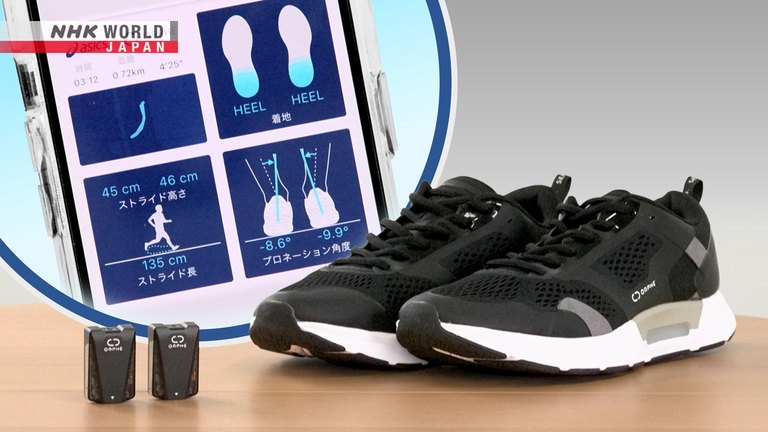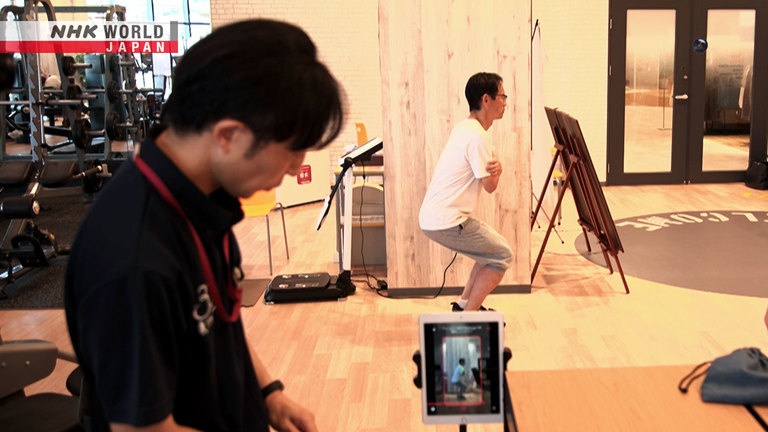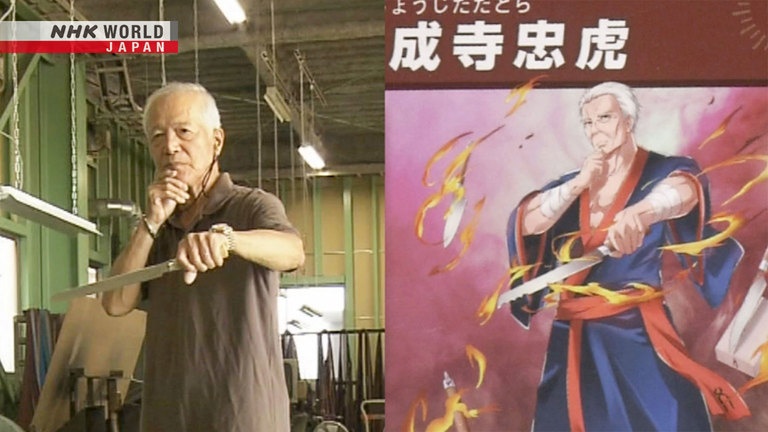Stepping into the Future with Fitness Tech
This episode features new developments in fitness training such as running shoes with performance-enhancing sensors and an AI-driven fitness app that helps personal trainers provide high-level instruction to their clients.
[In Focus: Climate Change Threatens Shipping on World's Waterways]
Wildfires, heat waves, drought ... extreme weather is having devastating consequences on Earth and economies around the world. We look at how shrinking water levels could stifle global trade.
[Global Trends: Japan's Trading Card Boom a Winning Hand for Business]
Trading cards are more than just fun and games in Japan. The hobby is becoming a booming business and companies are taking note, rolling out new ways of capitalizing on the trend.
*Subtitles and transcripts are available for video segments when viewed on our website.
Stepping into the Future with Fitness Tech


Global Trends


Transcript
The Panama Canal is facing an unprecedented climate crisis.
The passage connecting the Atlantic Ocean with the Pacific is essential for global trade.
But low water levels are limiting the number of vessels per day that can pass through.
Each ship requires about 200 million liters of water to move it through the locks.
"For the Panama Canal, this is a worrying and difficult situation, that's very complicated.
The transit of ships through the canal depends solely on fresh water.
And we get that from the rain."
Authorities said in late August: restrictions on the number of ships that pass through could last for a year without heavy rainfall.
"December isn't that far off.
With the holidays coming, goods for the shopping period are being delivered.
Some clients have approached us because winter is around the corner,
and growing shipments of energy products will increase traffic.
They are getting worried about the lines."
People in the shipping industry are also concerned about costs, which balloon as the waiting time increases.
"The traffic jam is clearly having an impact for some vessels.
There are moves to change routes to other places such as the Suez Canal.
If it doesn't rain continuously, we might be confronted with the toughest situation we've ever faced."
Meanwhile in Germany, a drought and heat wave are leading to growing worries
about the country's most important shipping route, the Rhine river.
Last summer, low water levels disrupted supply.
The situation has prompted people in the industry to try to adapt ships to climate change.
They've developed a new vessel, that can transport heavy cargo even with lower water levels.
Some of the crew cabins were downsized by about half to save weight.
They also made the ballast tank, which is used to control the float of the vessel, over four times bigger.
The cost of building the ship is twice as much as a conventional one.
"The ship is very innovative.
And I'm sure there will be more ships of this kind in the future."
Extreme weather around the globe is impacting economies and people's lives.
With climate change widely predicted to continue in the coming years,
businesses need to prepare for these unusual events to become the norm.
About 300 people are absorbed in a Pokemon trading card game tournament.
They prepare their decks for one-on-one battles, where winning depends on skillful use of the cards.
"It's fun to do a lot of preparation, and then pull off a win."
"I play with my children.
It makes me feel like a kid again."
The popularity of trading cards is creating a draw for new businesses.
This company, that primarily sells used books, is also getting into the game.
This store expanded its trading card section, and created a space where over 100 players can battle it out.
The store's monthly trading card sales have quadrupled compared to a year ago.
"It appears that more people are visiting as families.
I think it has a tremendous effect."
Japan's trading card market has expanded rapidly, exceeding 230 billion yen, or 1.6 billion dollars, last fiscal year.
Adults are a big part of the growth.
Many enjoyed the cards when they were kids, and now they're playing with their own children.
The buzz is creating opportunities for companies across the spectrum.
The Tsubame-Sanjo area of Niigata Prefecture, in central Japan, has long been known for metalworking.
Now the local industry is hoping to give itself a new shine with trading cards.
The characters are given different tools, weapons, and fighting techniques that represent the area.
For example, the character for a kitchenware company wields a whisk as a weapon.
This long-established company handcrafts knives one by one, using traditional techniques.
The character chosen as a motif is the company's chairman, who is also a craftsman.
"By choosing this motif, we wanted to express that we're focused on the craft.
Instead of showcasing our products, we've taken a different approach with these cards, that might bring different customers."
In July, organizers held the first competition using the cards.
"I was surprised that companies could be shown as characters."
Since sales began in 2019, over 90 businesses have taken part in the initiative, which has sold about 60,000 cards.
"We want to give people ample opportunities to learn about the region and its companies.
We hope they will visit the real-life locations and see them in action."
Japan is a content powerhouse, and trading cards are seen as another growth area.
For companies looking for new business avenues, the cards could prove to be a winning hand.
For runners who care about improving performance and increasing safety,
these "smart shoes" just might be the answer.
And cutting-edge, AI-driven analysis software is helping fitness instructors to give their clients customized workouts,
with detailed breakdowns of their strengths and weaknesses.
Today's On-Site Report features the latest developments in fitness tech!
Kato Takuya has been running for nearly 3 decades, and sometimes participates in major marathons.
At first glance, he's about to start his run with the basics: a pair of quality running shoes and a smartphone.
"Let's aim for another great run!"
Don't force a longer stride.
It's important to let it open up naturally, with your whole body.
Keep using good foot strikes.
You're using your whole body well and maintaining good form.
Kato is wearing "smart shoes" that contain sensors imbedded in each sole.
Both sensors stream a broad range of data to a dedicated app Katou is using on his smartphone.
The app uses AI to analyze his performance data in real time; and then provides him with advice and guidance as he runs.
Focus on tightening the muscles in your torso, and try running with a natural, slightly forward-leaning form.
When I first started running marathons, I often had pain in my left knee.
But since I started using this app, it feels much better.
Not only that, but my body as a whole feels great; and that really helps to keep me motivated.
The app presents the user with 12 different categories of useful information.
For example, it analyzes the runner's foot-strikes, and gives them advice on how to improve their form and lessen the impact on their bodies.
It can even determine the degree of a runner's ankle pronation: the inward movement of the ankle as it rolls to distribute impact force.
The sensor, shoes, and app were all developed by Kikukawa Yuya.
If shoes can help analyze individual running traits and tell athletes what they need to work on,
as well as how to prevent or avoid injury, that can increase performance and improve the overall running experience.
Kikukawa's first foray into "smart-shoe" making actually started with dance shoes.
He incorporated motion sensors into them as well,
but used them to let dancers program how their shoes emit light and sound, in relation to their dance moves.
He made the switch to running shoes after a chance encounter sprinter and three-time Olympian, Tamesue Dai.
I thought, if sensors could be used for gathering running data,
we could create something to help people with running issues to both recover and improve.
With Tamesue on board, the pair set out to develop a "smart shoe" for runners.
I think what makes our product stand out
is that amateur athletes can now get access to the same type of data and data analysis, as top professional athletes.
They partnered with one of Japan's largest athletic footwear makers to handle data analysis.
Their database of running information, gathered from over 10,000 athletes lets them provide feedback and advice to users.
One of the biggest challenges Kikukawa faced during development was data transmission from the sensors to the phone.
This is because the human body can block or interrupt radio waves.
He was able to solve the problem by changing the design of the sensors,
as well as adapting the shoes, so the sensors also emit radio waves from the sides.
The smart shoes were completed and ready for market in July of 2019.
A pair of shoes with 2 sensors costs about $260 dollars, and includes access to the app.
To date, they've sold over 3000 pairs.
By incorporating IOT into fitness, we want to create a healthier, happier world.
I hope to continue using technology more and more in pursuit of this goal.
This fitness club has multiple locations spread across much of Japan.
Its instructors provide customized workout routines tailored to each client's body type and physical abilities.
Being able to do this requires lots of experience and a great deal of knowledge.
To provide support to the instructors, the fitness club is having them use this special app.
For example, after taking and uploading a photo of a female client, the software then analyzes her posture.
It then shows how far her knees, pelvis, shoulders, and ears deviate from an ideal posture, and produces an evaluation score.
When viewed from the side, it shows that you have a slightly hunched posture, and your pelvis is tilted forward.
Without intervention, it's likely that your posture will worsen, with your stomach protruding further and your slouch worsening.
In addition to using AI to analyze the client's current posture,
the application also predicts their future body shape and suggests various exercises for improvement.
It really helps us to spot and diagnose issues a client may have, that are difficult or impossible to spot with the naked eye.
It can be really illuminating for both the instructor and the client once we can get an accurate measurement and analysis.
Takaku Yuya is CEO of Sportip, the company that developed the app.
He wanted to create an app that would allow instructors with varying degrees of experience
to all be able to provide high quality feedback and coaching to their clients.
I think we've created a product that allows any level of instructor to provide top level-guidance,
that in the past only the best of the best could offer.
In order to perfect the app, Takaku and his team spent 3 years conducting joint research with Tsukuba University,
one of Japan's leading schools in the field of exercise physiology.
The app also offers a motion analysis function that can be used to capture specific body movements during exercise.
This allows instructors to point out improper form issues to their clients,
and give more effective instruction on how to correct or improve their form when exercising.
If you try to move with your ears, shoulders, and hips in alignment,
it will help you to strengthen the muscles around your lower back.
Since implementing the app, this fitness club has seen an increase in both customer satisfaction, as well as retention rates.
Using this app has helped me to see some positive results, so I'm really glad to be able to use it with my training.
In addition to the initial usage fee, here is cost breakdown for using the application.
To date, the application is currently being used at over 300 fitness clubs across Japan.
I hope that by providing quality support to fitness instructors, I can contribute to the improved health of each and every one of their clients.